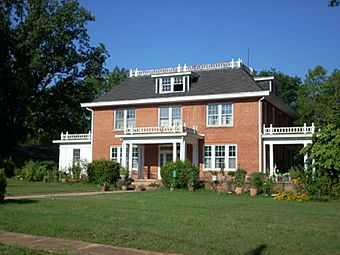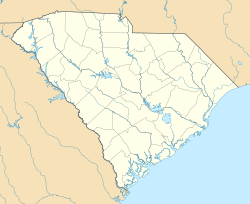J. Warren Smith House facts for kids
Quick facts for kids |
|
|
J. Warren Smith House
|
|

J. Warren Smith House in 2009
|
|
| Location | 21 N. Palmetto St., Liberty, South Carolina |
|---|---|
| Area | less than one acre |
| Built | 1927 |
| Architectural style | Colonial Revival |
| NRHP reference No. | 04001564 |
| Added to NRHP | January 26, 2005 |
The J. Warren Smith House is a historic home located in Liberty, South Carolina. You can find it at 21 North Palmetto Street. This house is special because it's a great example of Colonial Revival architecture. It also has a cool connection to J. Warren Smith, a local business leader.
The house has been known by other names too! People called it "Maggie Manor" and the Myrtle Inn when it was used as a boarding house. Because of its importance, it was added to the National Register of Historic Places in 2005.
Contents
History of the J. Warren Smith House
Who Was J. Warren Smith?
J. Warren Smith was born in Anderson, South Carolina, in 1880. He grew up and first worked in farming. Later, he became a carpenter for six years. He then started working for International Harvester, selling farm equipment and learning about gas engines.
In 1910, Mr. Smith decided to start his own company. He founded Liberty Light & Power. This company used two gas engines to create electricity for the town of Liberty. As the town grew, more power was needed. So, he sold his company to Duke Power. As part of the deal, he got a job for life with Duke Power! He became the manager for Pickens County.
In 1937, he moved to Greenville to work in Duke's Rural Electrification Department. This department helped bring electricity to country areas. He sold his house in Liberty in 1941 and retired in 1955. J. Warren Smith passed away in 1968.
The House's Story
Around the time he sold his power company, J. Warren Smith began building this impressive house. It was designed to show his important place in the community. Building the house probably took several years to finish.
In the 1930s, the house started being used as a boarding house. This meant people, like local teachers, could rent rooms there. Eventually, the house became known as "Maggie Manor." This name came from Mattie Smith, who was J. Warren Smith's wife.
When the house was sold in 1941 to L. J. and Sybil Kelley, it got a new name: the Myrtle Inn. Mrs. Kelley's mother, known as "Granny Chamblin," lived there too and was the cook. The Myrtle Inn was a popular spot for lunch. Many local business people would eat there. It continued to be a place for boarders and travelers until 1970. The house was sold again in 2003.
Architecture of the House
Outside the House
The J. Warren Smith House is a large, two-and-a-half-story building. It is covered in brick and sits on a brick foundation. The front of the house faces east. It has a special roof called a hip roof, which slopes down on all sides. There's also a decorative fence, called a balustrade, around the top of the roof. The roof also has wide edges that hang over.
You can see three dormers, which are windows that stick out from the roof. They face east, south, and north.
The house has two main entrances, each with its own porch. These porches are supported by Doric columns. These columns are a classic style, known for being simple and elegant. The main entrance is on the east side, facing Palmetto Street. The family entrance is on the north side, on Edgemont Street. There was also a porch on the south side, but it was enclosed in 1970. Another small porch on the west side was also enclosed around the same time. The ceilings of the porches are made of bead board, which is a type of wooden paneling.
The windows on the front of the house are mostly "six over six" sash windows. This means each window has two parts that can slide up or down, and each part has six small panes of glass. The dormer windows are similar but a bit smaller.
Inside the House
The first floor of the house has very tall ceilings, about 10 feet high! The main room on this floor is the living room, right off the main entrance. It has dark oak baseboards that are 10 inches tall. The house has beautiful hardwood floors, though the living room's floor is covered with carpet. There's also a fireplace in the living room, made to look like brick, with a marble mantel.
Other rooms on the first floor include the dining room, a central hall with stairs, a breakfast room, and the kitchen. There's also a master bedroom and bathroom on this floor. The dining room has special doors with fifteen glass panes that lead to the south porch. The kitchen is in the back corner of the house.
The second floor has 9-foot ceilings. It has six bedrooms and two bathrooms. Each bedroom has a "six over six" sash window, just like downstairs. The decorative trim around the rooms is the same as on the first floor. Only one of the bathrooms still has its original sinks and tubs. The other bathroom was actually made from a closet! There's also an attic, which was planned to have water lines but was never finished. It's used for storage now.
The Basement
The front part of the basement is a crawlspace, which is a low, unfinished area. The back part is dug out and holds the house's utilities. It even has a central vacuum system! This means there are connections in each room where you can plug in a vacuum hose. The house is heated by a coal-burning furnace that creates steam. A conveyor belt system brings coal from a utility room in the basement to the furnace. In 1970, the basement was changed to include a bedroom and a new ceiling.



